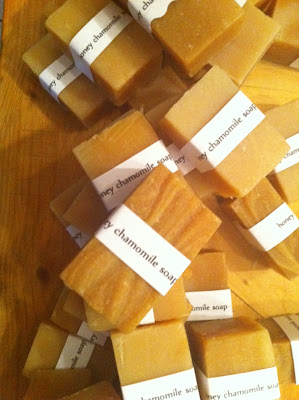making soap
I started making soap in 1990 as a way to use the gallons of fat rendered from cooking sausage at my dad's restaurant. I got the soap recipe from a Foxfire library book. Those bars were green and gorgeous, hard as rocks, and the nicest soap I have ever made -- but they smelled like soapy sausage.
Now I make all-vegetable soap based on Ann Bramson's recipe. This is a simple version of how I do it... I won't say it's not a dangerous process -- I recommend reading all you can about the soapmaking process before you attempt it and I don't recommend attempting it if you're squeamish about it.
32 oz COLD water, not even a tiny bit warm

Now I make all-vegetable soap based on Ann Bramson's recipe. This is a simple version of how I do it... I won't say it's not a dangerous process -- I recommend reading all you can about the soapmaking process before you attempt it and I don't recommend attempting it if you're squeamish about it.
 |
| honey chamomile soap, marbled with turmeric |
soap
10 3/4 oz lye32 oz COLD water, not even a tiny bit warm
44 oz olive pomace oil
17 oz coconut oil
24 oz palm oil
1 oz essential oil (one, or a combination)
1 TBSP grapefruit seed extract or vitamin E as preservative
You will also need:
a kitchen scale
2 two-quart pitchers, one of which is plastic and has a lid
a large stainless-steel soup pot
a wooden or stainless-steel long-handled spoon
a large shoebox or other mold with lid
1 kitchen garbage bag and tape
1 or 2 thick bath-size towels
1 TBSP grapefruit seed extract or vitamin E as preservative
You will also need:
a kitchen scale
2 two-quart pitchers, one of which is plastic and has a lid
a large stainless-steel soup pot
a wooden or stainless-steel long-handled spoon
a large shoebox or other mold with lid
1 kitchen garbage bag and tape
1 or 2 thick bath-size towels
- On a kitchen scale, zero a Rubbermaid-type 2-qt pitcher. Run filtered tap water into another pitcher, and then pour 32 oz water into the lye pitcher. Into the lye pitcher, slowly pour the lye to reach the combined weight of lye and water (42 3/4 oz). The lye mixture will become hot as hell. Be careful not to splash the lye, it will burn holes in your clothes, your kitchen rug, and your skin (if you do happen to splash some lye on yourself, pour some plain vinegar over the splash to neutralize it).
- Take the lye pitcher off the scale and stir the lye gently with the long handle of a wooden spoon or with a stainless steel spoon. Put the lid on the pitcher in the open position so that steam can escape, and let the lye cool on the countertop for several hours. Wash the spoon; you'll use it again.
- While the lye is cooling, prepare molds. This batch will make a large shoebox -- line the box with a plastic garbage bag, taping the bag to the box as neatly as you can. Save the box lid; you'll use it to keep the heat in once you've poured the soap.
- On the kitchen scale, zero a large stainless steel soup pot. Weigh the oils into the pot, then heat briefly on the stove over medium heat, just until the solids are melted.
- Bring the lye pitcher and the oil pot to just above body temperature (you can measure this with a thermometer, or simply touch the OUTSIDE of the pitcher and pot and test against your own body temperature). You can cool them by placing the pitcher or pot or both in an ice bath in your kitchen sink, or warm them by resting in a sink of hot tap water.
- When the lye and oils are each at just above body temperature, move the pot to the COOL stovetop. Start stirring the oils with the spoon, and then slowly drizzle in the lye in a steady stream while you stir.
- Keep stirring the oil/lye mixture until it becomes very thick and "traces." This means that if you spoon out some of the mixture, you can drizzle it on top of the mixture in the pot and see the pattern -- the mixture will support itself for a few seconds at the trace stage. Once you have the lye incorporated, you can speed up the stirring by blending the soap with a stick blender on low speed until the trace stage.
- When the soap is thickened, quickly stir in the essential oil and preservative oil, if using it.
- Pour the soap into the shoebox, put the box cover on, and cover the box with a thick towel. After a few minutes, the soap will become very hot -- don't peek until it has cooled down. The cooled soap may be very liquid; it will harden after a day or two.
- Wash all of the soapmaking stuff (pitcher, lid, spoon, pot...) with hot water and dish detergent; you can use all of these things again for food, as usual.
- When the soap has hardened, turn it out of the box onto a brown paper bag and let it harden further for several days.
- Cut into bars and keep them cool and dry until you use them.
This might go without saying, but I'm saying it: the above is for entertainment purposes only -- I make no claims as to the validity or safety of any of it. Salut!



Comments